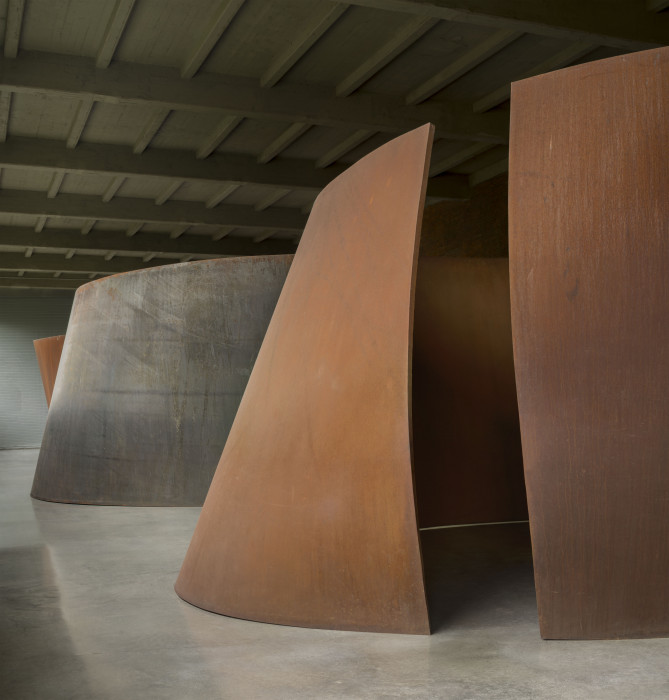 |
George Etheredge for |
This is the third time I am writing about art and the second time this year. I am writing an obituary/reflection after learning that Richard Serra passed away on March 26th at the age 85.
Richard Serra was an acclaimed American sculptor known for his monumental works that explore the concepts of space, weight, and materiality. He is known for massive works of art. Massive may even be understated. Technically, his works might be classified as sculptures as they are three dimensional. To me, they are huge production pieces that are more feats of visionary manufacturing than sculptures. His medium is steel. Grandiose rolled steel slabs, wavy, curved, conical, basically huge geometric shapes. The sculptures are so large, they are created at a steel factory in Germany that fabricates rolled steel plates for, amongst other uses, ship hulls. His sculptures are so large, that the galleries in which they are viewed must be specially reinforced to support his multi-ton pieces e.g. his piece Equal (2015) is comprised of eight 40 ton blocks of forged steel.
Serra was born on November 2, 1938, in San Francisco, California, Serra developed an interest in art from a young age. He attended the University of California, Berkeley, where he initially studied English literature before shifting his focus to art and receiving his Bachelor of Arts degree in 1961. Serra continued his education at Yale University, where he earned a Master of Fine Arts degree in 1964. During this period, he studied under Josef Albers and became influenced by abstract expressionism and minimalism, which would later shape his artistic style. To support himself while studying at Yale, Serra worked for US Steel which no doubt contributed to the medium he later created.
In the late 1960s and early 1970s, Serra gained prominence as part of the minimalist art movement. He started creating large-scale sculptures using industrial materials like steel, often employing geometric shapes and simple forms. One of his early notable works is the "Verb List Compilation: Actions to Relate to Oneself" (1967-1968), which laid out a series of actions that would later inform his artistic process. This exhibit has been called “both art and a to-do list.”
Throughout his career, Serra's sculptures have challenged conventional ideas about sculpture and its relationship to space and the viewer. Challenged? Squash conventional ideas under 40 tons of forged steel is more like it. His works provoke physical and emotional responses, encouraging viewers to engage with the art in a direct and visceral manner. The physical and emotional response can be positive (like mine) or negative (is this really art?). One of Serra's most famous series is the "Torqued Ellipses," which he began in the 1990s. These massive, curved steel sculptures twist and turn, creating dynamic and immersive environments that play with perception and perspective. One has to walk around them and through them like a maze and then view them from a balcony to fully experience and appreciate them.
Serra's work has been exhibited and installed in various museums and public spaces around the world. His notable installations include "Tilted Arc" (1981), a controversial public sculpture in New York City that sparked debate and legal battles over its removal, and "The Matter of Time" (2005), a series of monumental steel sculptures exhibited at the Guggenheim Museum Bilbao.
In addition to his sculptures, Serra has also worked in film and video art, exploring movement and duration in a different medium. He has received numerous awards and honors for his contributions to contemporary art, cementing his legacy as one of the most influential sculptors of his generation.
While working in Manhattan, I had become a fan of Serra. I went to a NY exhibit of his work at the Museum of Modern Art (MOMA). I had no clue who Serra was and what he did, I went to the museum as I occasionally did with no goal of seeing anything in particular. I suppose you might say I like to experience new art and artists with zero knowledge and zero preconception. This blissful naivete was certainly the case when I stumbled upon the gallery of his work. I was instantly a fan. I loved his audacity, fascinated with his vision, and amazed by the project management required to create these items. The second time I saw his work was in Bilbao where I happened to be delivering a course on quality management. This was even bigger and bolder than what I saw in New York.
In both viewings, I dragged my hand along the ten-inch thick, 40 ton, sculptures to add a tactile dimension to the art experience. In both cases, a museum guard scolded me not to touch the art. Really? I laugh about it every time I think about it.

© Richard Serra/Artists Rights Society (ARS), New York. Photo: Bill Jacobson Studio, New York

No comments:
Post a Comment